


Bretsch 3 is a grand dolmen consisting of five pairs of supporting stones and a rectangular enclosure. The current state of preservation is good, only a few stones are missing. The enclosure is northeast-southwest orientated and 32 m long and 7 m wide. The enclosure consists of thirtyeight stones, eight stand still upright, some are bursted. A stone lying just outside the enclosure in the east could be interpreted as a turned-over guardian stone, but more likely that it is a capstone of the chamber displaced here. The chamber is also ortheast-southwest orientated and lies in the middle of the enclosure. It measures 6 m x 1.8-1,5 m. All twelve wall stones are preserved and still stand upright. One capstone (2.7 m x 1 m x 0.9 m) is completely preserved, another one of probably five only incomplete.
Drive on the L12 from Bretsch towards Drüsedau. Pass Bretsch 2 (on your left) and Bretsch 1 (on your right). 800 m after Bretsch 1 you reach the edge of a forest, continue for another 350 m and park your car (N52° 51’ 01.6” E11° 39’ 53.3”), where a forest track on the left side leads in a northwestern direction. Follow this track for about 950 m, which leads you in a straight line to the tomb until just before the end of the forest. On the left, about 30 meters from the path, lies the tomb.
Unfortunately, during my visit, the tomb was heavily overgrown with undergrowth and brambles, so the structure was not easily recognizable. Too bad, on older pictures, the tomb looks very promising. Here, the shrubbery should urgently be trimmed, otherwise in a few years the tomb will probably no longer be recognized.
Visited April 2019



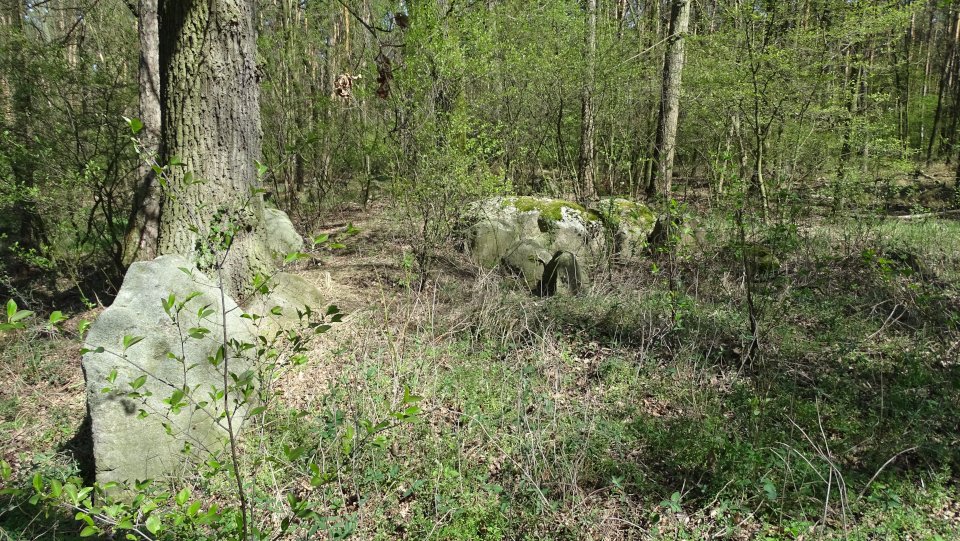





Hohenwulsch-Friedrichsfleiß is a grand dolmen consisting of seven pairs of supporting stones and probably an oval enclosure. The current state of preservation is moderate, the enclosure is missing for the most part, the largest capstone has burst and fallen into the chamber. The location of the six remaining enclosure stones suggests that the enclosure was once round or oval. Outside diameter: 13.3 m in east-west direction. The chamber (7.4 m long, 1.8 – 2 m wide) is also east-west orientated and lies in the middle of the enclosure. Fourteen of formerly sixteen wall stones and four of formerly five capstones are preserved. The biggest, broken capstones measures 2.6 m x 2 m x 1.2 m.
Drive on the K1069 from Friedrichsfleiß towards Schorstedt. Immediately before Freidrichshof turn right towards Grassau. After about 1 km you will reach a larger forest road (N52 ° 40 ‘34.1 “E11 ° 39’ 30.9”) coming from the south. Park the car here and follow the forest path in a southerly direction for about 550 m, here crosses the way from Friedrichsfleiß to Grassau. At the intersection, turn right towards Friedrichsfleiß and follow it for about 80 m. The tomb lies here left of the way.
taken from the information board:
Megalithic tomb G R A S S A U
Megalithic tombs are silent witnesses of the past.
More than 4500 years ago, the inhabitants built these places of worship. Only rolls (logs) and piled-up inclined planes were used to transport the tons of boulders. What a performance. It could only have been Titans or Giants.
The term megalithic tombs dates back to the Middle Ages. The stones for the graves were brought or pushed from northern Europe, central and southern Sweden in the ice age in our area by glaciers (debris).
In 1843 there were 34 tombs in the district of Stendal, today there are only 4 in the area of Kläden. The remaining tombs were used as building material.
About 100 m west of the crossing Grassau – Friedrichsfleiß and Bülitz – Schorstedt are the remains of this megalithic tomb. The cracked capstone rests on four wall stones. Another 10 stones of the burial chamber and enclosure are still present.
Besides this tomb are still preserved:
Graves on the Trappenberg near Bülitz, west of the road towards Grünenwulsch, north of Steinfeld.
Further, but no longer existing megalithic tombs lay between Schmoor (Friedrichshof) and Grassau near the deserted medieval town Finschow. Two more in the district Grassau, between the Schartauer and the Schorstedter road. There was a grave in Kläden. It formed with some stones the basis for the built in the 30s war memorial on the church hill.




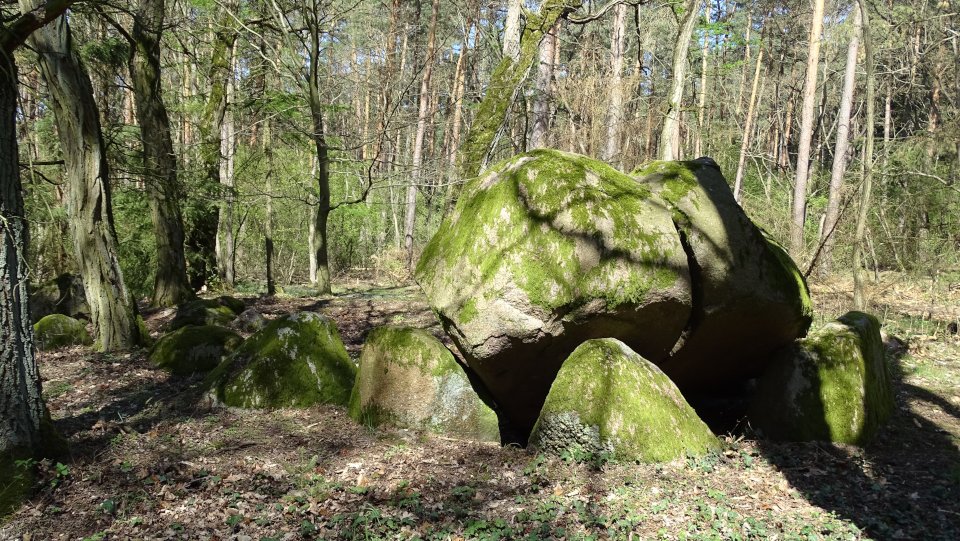


Panorama shot
Visited April 2019

Panorama shot
Visited April 2019

Beesewege is a destroyed grand dolmen consisting of five pairs of supporting stones and a trapezoidal enclosure. The condition is very bad, only two stones, which probably belong to the chamber, and a stone of the enclosure, broken in three parts, are present. Even in the first half of the 19th century, the megalithic tomb was well preserved except for several missing capstones. The length of the trapezoidal enclosure was then 39 m, the width of 8.2 – 12.5 m, an imposing capstone (3.2 mx 2.2 m) rested on four or five support stones. The chamber itself, like the enclosure, was probably oriented west-east.
After 1870, the megalithic tomb was largely destroyed. The stones were used in the construction of a path underpass through the emerging railway Bremen – Berlin (“Amerikalinie”) as a reinforcement of the railway embankment. They should still be in the railway embankment today.
The picked up stones are a recent “additon” of an idiot with no respect of this ancient site, because on older pictures, they are not present.
The tomb can be reached from Beesewege towards Bülitz. About 100 meters before the last houses, where the village road turns to the northeast, a road goes to the southeast (cycle path from Beesewege to Kläden). This road soon turns into a bad dirt road, park here. Walk for about 800m on this dirt road until you reach the edge of the forest. There you turn left and then, after about 50 meters, you will find the remains of the tomb left of the path.
Visited April 2019



Remains of the enclosure
Visited April 2019




site plan according to Krause / Schoetensack 1893
Visited April 2019

Megalithic tomb Beesewege.
Illustration from: Historische Beschreibung der Chur und Mark Brandenburg (1751)
Visited April 2019
Bülitz is a grand dolmen consisting of five pairs of supporting stones and a trapezoidal enclosure. The current state of preservation is good, at least two capstone and most of the enclosure stones are missing, however the existing stones are still all upright. The enclosure is largely destroyed. It consists of only six stones and reaches a width of 9.4 m. In 1843, during the recording of Danneil, it was still in a very good condition. He described the enclosure as trapezoidal with a length of 26.7 m and a width between 8.8 m and 10.0 m. At that time the enclosure still had extra large guardian stones. The chamber is nordeast-southwest orientated and measures 5.7 m x 2.2 – 1.7 m. Twelve wall stones and one of the formerly presumably three capstones have been preserved.
On the northeast side of the tomb leans a large sandstone slab with a now washed-out inscription. This is, as in Kläden 6, a slab of the canon of Levetzow mentioned in 1893, who had bought this tomb in order to save it from destruction.
Drive from Bülitz towards Beesewege. About 800 meters behind Bülitz there is a group of houses on the left hand side. Just behind the last house leads a path to the grave 60 meters away.
Visited April 2019


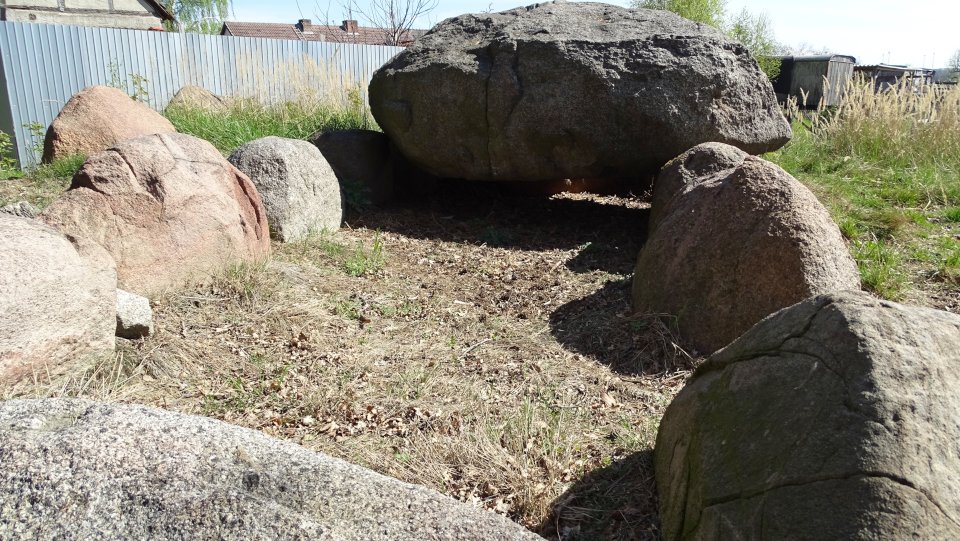


Note the leaned sandstone slab on the north-east end
Visited April 2019


Kläden 6 is a grand dolmen consisting of eight pairs of supporting stones and a trapezoidal enclosure. The current state of preservation is moderate, at least one capstone is missing, the others are partially cracked and partially sunken, many enclosing and wall stones have fallen or are missing. The enclosure is south-north orientated. It is quite short in comparison to the remarkable large burial chamber, 18 m long outside and between 7.5 m in the south and 8.2 m in the north. Nineteen of formerly perhaps twenty-six surrounding stones are still present. The chamber is also south-north orientated and lies in the middle of the enclosure. Twenty wall stones and six of formerly seven capstones are preserved. The chamber measures 11 m x 1.5 m (south) – 2.6 m (north).
On the east side of the complex, roughly in the middle of the tomb, lies a broken, inscribed sandstone slab. Like the grave of Bülitz, it is a board of the canon of Levetzow, who bought the tomb to preserve it. The slab was to be used around 1950 for the construction of an Ernst Thälmann monument. But when they wanted to lift the slab from the grave, it broke into two pieces and then left the two pieces there.
Drive from Steinfeld to Kläden, in Kläden turn right towards Grassau. After about 2 kilometers there is a wind turbine on the right side of the road. There you can park the car. The tomb is then on the other side of the road, about 60 meters away, in a larger and dense bush group. Shortly before my visit, the strong plant growth around the grave must have been cut back, otherwise it seems to be heavily overgrown.
Visited April 2019
taken from the information board:
Megalithic tomb K L Ä D E N
kleiner Trappenberg
Megalithic tombs are silent witnesses of the past.
More than 4500 years ago, the inhabitants built these places of worship. Only rolls (logs) and piled-up inclined planes were used to transport the tons of boulders. What a performance. It could only have been Titans or Giants.
The term megalithic tombs dates back to the Middle Ages. The stones for the graves were brought or pushed from northern Europe, central and southern Sweden in the ice age in our area by glaciers (debris).
In 1843 there were 34 tombs in the district of Stendal, today there are only 4 in the area of Kläden. The remaining tombs were used as building material.
This grave west of the road to Grünenwulsch, on the kleiner Trappenberg, is 18 m long, 12 m wide and consists of 50 stones. The burial chamber consists of 22 supporting and 7 capstones.
Besides this tomb are still preserved:
Graves on the großen Trappenberg near Bülitz, north of Steinfeld, west of the crossing of the routes Bülitz – Schorstedt and Grassau – Friedrichsfleiß.
Further, but no longer existing megalithic tombs lay between Schmoor (Friedrichshof) and Grassau near the deserted medieval town Finschow. Two more in the district Grassau, between the Schartauer and the Schorstedter road. There was a grave in Kläden. It formed with some stones the basis for the built in the 30s war memorial on the church hill.


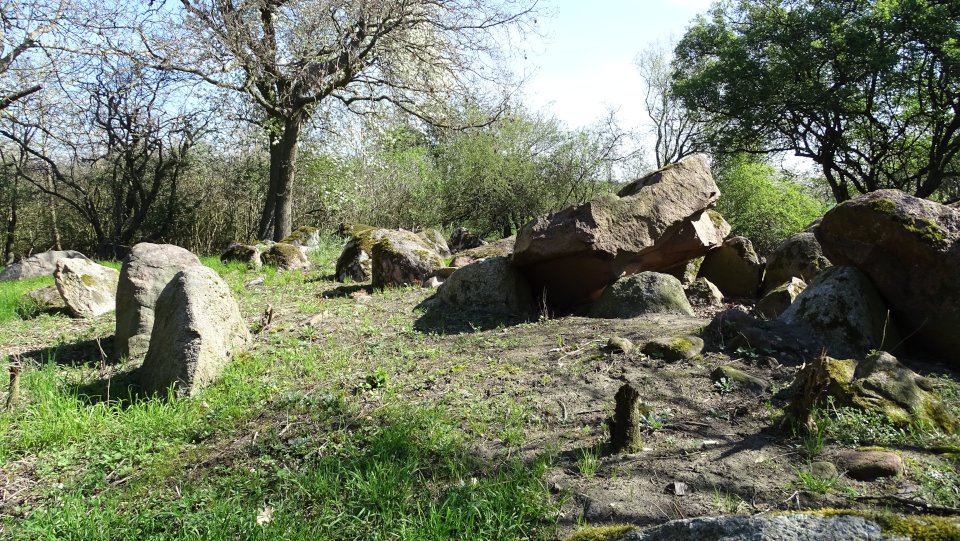



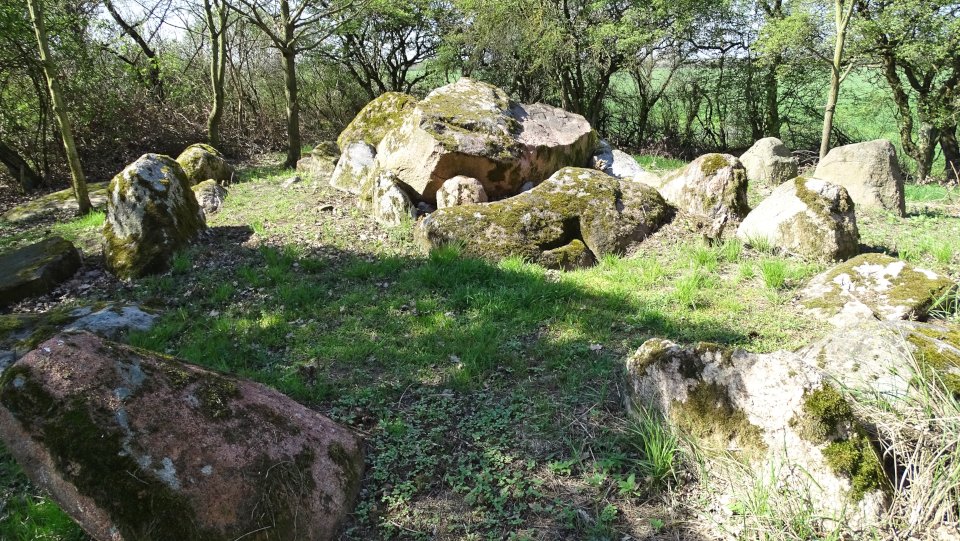

Panorama shoot, note the brocken slab on the left
Visited April 2019
